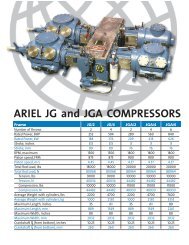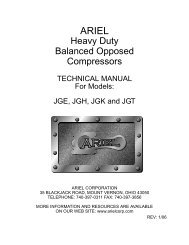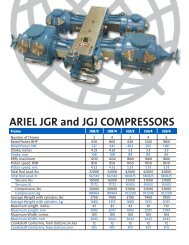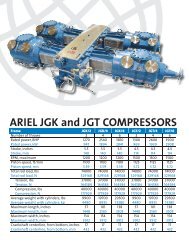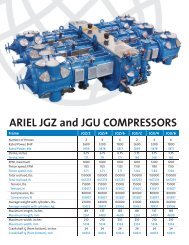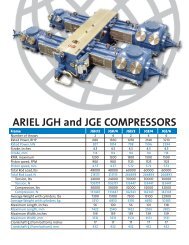Heavy Duty Balanced Opposed Compressors
Heavy Duty Balanced Opposed Compressors
Heavy Duty Balanced Opposed Compressors
You also want an ePaper? Increase the reach of your titles
YUMPU automatically turns print PDFs into web optimized ePapers that Google loves.
FOR MODELS: JG AND JGA SECTION 5 - MAINTENANCE<br />
drive end and auxiliary end straight down into the crankcase, wearing clean<br />
gloves as during removal. Both drive end and auxiliary end journals should<br />
touch the bearing saddles at the same time.<br />
2. When the crankshaft is resting on the bearing saddles, attach the bearing caps<br />
with the capscrews lightly snugged. Then, starting at the thrust end, tighten the<br />
bolts in a crisscross pattern in 25% increments to the recommended torque<br />
value in Table 1-15 on page 1-15. Bearing caps are match-marked to correspond<br />
with the spacer bar and spacer bar bosses on the frame.<br />
3. Be sure the dowels in the bearing caps are aligned with the holes in the crankcase<br />
base. A set screw on top of each dowel prevents it from backing out.<br />
4. Measure each crankshaft journal bearing jack clearance, with a dial indicator<br />
and magnetic stand to Table 1-2 on page 1-8. To measure main bearing clearance,<br />
turn the adjacent crankshaft pin up and mount the indicator stand on the<br />
main bearing cap, with the indicator stem touching the web of the crank adjacent<br />
to the bearing cap. Push down on the crank, set indicator to zero, pry up,<br />
observe and record reading. This is best done before the connecting rods are<br />
installed by pulling a clean lifting strap around the adjacent pin and pulling up on<br />
the crankshaft with a crane or bar on the strap.<br />
5. Reattach the connecting rods (See “Connecting Rod - Installation” on page 5-4),<br />
packing diaphragms, and unloaders/head end heads.<br />
6. Reinstall the chain drive. (See “Chain Drive System” on page 5-12).<br />
7. Replace the spacer bars. Locate the match mark on the spacer bar. Install the<br />
spacer bar so that the match mark is up and next to the spacer bar boss with the<br />
same marking. Tighten bolts to the value in Table 1-15 on page 1-15.<br />
8. Install new end cover gaskets. Examine the top cover gasket. If there is any<br />
doubt that it is not in good usable condition, install a new gasket. Before installing<br />
gaskets, apply an antiseize lubricant to all gaskets or to the metal surfaces<br />
on which they will seat. This will aid in their easy removal at a later date. Trim<br />
the excess from the new end cover gaskets flush to the base with a knife after<br />
end covers have been re-bolted.<br />
9. Reinstall the drive end cover and the top cover. Replace and tighten bolts.<br />
Chain Drive System<br />
Description<br />
The chain drive system is crankshaft-driven at the auxiliary end of the frame. The chain runs<br />
the lube oil pump and force feed lubricator. Chain tightness is controlled by an idler sprocket<br />
attached to the eccentric adjustment cap. The chain dips into the crankcase oil and, as a<br />
result, is constantly lubricated. See Figure 5-7:, for the auxiliary end components and chain<br />
drive system.<br />
Replacement of any parts that can change the position of the drive sprocket on the crankshaft<br />
(i.e. crankshaft, drive sprocket), and/or loss of the as built sprocket position of driven<br />
components, can require repositioning the lube oil pump and force feed lubricator sprockets.<br />
Center crankshaft in end play. With a good straight edge, check to see that sprockets are<br />
aligned within 1/32 inch (1mm). Or measure the distance between the inside face of the aux-<br />
PAGE 5 - 12 11/01





